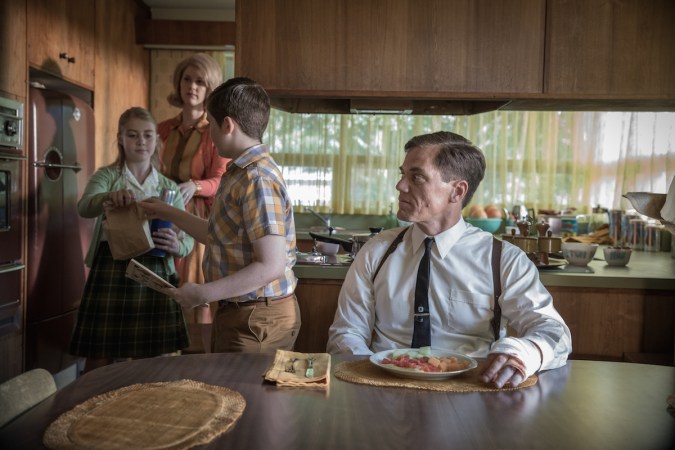Guillermo del Toro’s latest, The Shape of Water, is a scathing indictment of American parochialism. True, it’s also more explicitly about how a mute woman who enjoys masturbating in the mornings ends up falling in love with a lithe scaly fish-like creature who loves hard-boiled eggs, but then again, del Toro’s adult fairy tales have always been driven by social commentary. The Devil’s Backbone literalized the horror of the Spanish Civil War, Pan’s Labyrinth put the loss of childhood innocence at the center of the fight against a fascist regime, and a film like Crimson Peak used gothic melodrama to discuss female agency and indict the dying breed of the Old World. So, while on the surface del Toro’s Cold War take on the beauty and the beast story seems more whimsical than we’re used to—it’s more indebted to Hollywood studio musicals than any other genre around—The Shape of Water is the kind of resistance-driven tale only a Mexican director could make in 2017.
Del Toro said as much when he screened the movie at the Toronto International Film Festival earlier this year. That’s why he’d chosen to set it in 1962, which is, as he told the crowd at TIFF, the time that Americans go back in their imagination when they say “Make America Great Again.” “It’s the time when the fantasy of America almost crystallized,” he added. “If you’re white Anglo-Saxon and Protestant it was a great time to be alive. If you’re not then it’s pretty bad. The idea was to say, that was then—but it’s also now.” And so watching the film in 2017, one cannot help but see the echoes of what del Toro was pushing, especially when the heroes of the movie come from so many disenfranchised groups. In addition to Elisa (Sally Hawkins), a woman who’s literally voiceless, you have Zelda (Octavia Spencer) a working class black woman, Giles (Richard Jenkins), a gay art director, and, of course, the amphibian man himself (played by Doug Jones, aka the Pale Man, aka Abe Sapien.)

While this aquatic creature may be treated like a monster by the U.S. government, the film reminds us time and time again that he’s a wondrous being worthy of our admiration (and of Elisa’s love). Del Toro and Jones have spoken openly about how they wanted to move away from making “Charlie” (as in Charlie the Tuna) grotesque. Instead, the director asked his longtime collaborator to infuse him with the swagger he’d seen in Jones when he played the Silver Surfer in the Fantastic Four sequel and to think of matadors when working on his movements. The goal was to make this creature feel sexy, for him to feel smooth, and powerful, and alluring. (It’s no surprise that in several interviews both Hawkins and Spencer have pointed out the bubble butt that Jones got to sport and which del Toro lovingly shoots in the movie.)
Moreover, in trying to humanize what would otherwise remain an Other—and no doubt informed by what he’d been seeing in the world at large while writing the film—del Toro made the creature a God from the Amazon. “My Hispanic roots, my Mexican roots are with me all the time,” he exclaimed at TIFF. It’s obvious in his choice to not make Elisa’s sexy monster lover some creature from the American gothic tradition or from Hollywood B-movie swamp lands, instead opting to make him Latin American. Of course, we only get to hear this tidbit of information from the movie’s resident villain, Strickland (played by Michael Shannon), a cruel and ruthless government agent with a penchant for violence.
“Ain’t that something?” he boasts when introducing the monster, “Ugly as sin. The natives in the Amazon worshipped it” only to later elaborate to his superior that “they were primitives, sir. Tossed offerings into the water; flowers, fruits, crap like that… Tried to stop the oil drill with bows and arrows. That didn’t end too well.” And that’s how, in one fell swoop, this water being—a God, no less—becomes yet another victim of the US nationalist and imperialist project. Not only has his godliness been dismissed because of the presumed primitive nature of those who idolized him, but he’s to be used as a tool to help win the Cold War—a way to assert supremacy over the Soviet Union and thus assert the primacy (supremacy, really) of American culture in the eyes of the world.

Therein lies del Toro’s most trenchant commentary in the film. Where these heroes form a ragtag band of misfits made up of communities and identities that are often dismissed if not openly despised by the so-called majority, The Shape of Water is clear about what its villain stands for.
“I want you to play this guy who works for the government in the ’60s and he’s struggling,” Shannon told the crowd at the TIFF press conference, explaining how del Toro had approached him about the project. “He wants to succeed. He has a family. He’s under a lot of pressure. He kind of embodies this kind of American anxiety. On the surface, he’s a bulletproof veneer and underneath there’s a lot of uncertainty. It leads to a certain violence.”

While Shannon never saw Strickland as a villain, thinking that too simple a way of understanding this man, he remains undeniably the cruelest and least redeeming character we meet. He tortures the creature with gleeful abandon. He humiliates Elisa and Zelda at every chance he gets. And, perhaps most tellingly, he embodies a vision of the United States that remains enshrined in popular culture, only to offer its nightmarish underbelly. When his son Timmy asks him whether there’ll be jetpacks in the future, he answers with the kind of platitude you’d easily find at a political rally in 2017: “That’s right, son. The future is bright. You gotta trust in that. This is America.”
He may have a beautiful wife, two perfect kids, a gorgeous house and a cool-ass car—he is the American dream incarnate—but that just makes his bouts of anger all the more egregious. And it makes Elisa’s romance all the more transgressive, a beautiful example of what it means to love not despite what’s on the outside, but in tandem with it. At its heart The Shape of Water critiques a view of an American gone by recentering its narrative on those on the margins and making them heroes of their own splashy Hollywood romance flick. It’s as staunch a rebuke of the MAGA crowd as you’re bound to find in a film where neither lead utters a word but whose very presence speaks volumes.
The Shape of Water is currently in limited release and opens nationwide on December 22.




